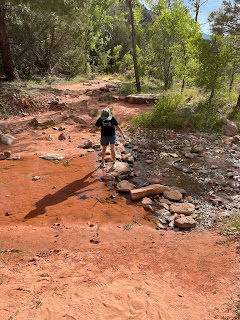Dishonest Recognition
This is about how people fail to escape the bad patterns forming in their lives. Their friends may notice the trends; and sometimes the people who are causing the patterns see them, too, and realize they are harming themselves; and yet they fail.
At the core of the failures to stop these slides into personal disaster, there seems to be a sort of dishonesty. The person caught in the pattern of bad behavior rationalizes to themselves in any way they can to avoid the responsibility for making a change.
1. They will deny the trend exists regardless of many others noticing it.
2. They will deny the situation amounts to a problem.
3. They will say they need more time to address the problem.
4. They will blame the problem on someone else. Like the other responses, this is a declaration that they don’t intend to change.
5. They will claim the problem is unsolvable, the pattern immutable. Although this is nicer because it doesn’t place the blame on others, it is still an announcement of intent.
Everyone seems to have some of these behaviors. This doesn’t mean no one escapes the bad habits they’ve established but it does point out how insidious life patterns can become. It’s hard enough already to recognize the patterns, the underlying causes, and the solutions; and it seems awfully easy to justify not taking the necessary actions.
Examples:
1. If you hear something like, “I’ve been drinking more but it’s only social drinking,” you can know this is how your friend is rationalizing something that’s become a problem as being not a problem.
2. If you hear, “Other people eat as much as I do,” or “Other people sleep more than me,” you might recognize this as slightly hopeful, in that the person developing the problem is willing to acknowledge the trend, just not the negative consequences.
3. “I’m working on it,” or “I’ll get to it” may sound positive until you notice the person is effectively declaring they need infinite time. It takes a while to notice. But only when there is no choice or it is, in fact, too late will they try to act.
4. “She shouldn’t have left me,” or “I only smoke because of all this stress,” or even “If everyone would stop giving me advice, I’d be fine” are all hostile attempts by problematic people to not only to avoid change but to paint themselves as helpless victims. Of all the responses, this one is probably the most discouraging. That’s because it can feel so comforting to see oneself as a victim. Not only does the person not intend to change, they’ve managed to feel good about it.
5. “I’ve got ADHD,” “Can’t you see my foot is broken?” “I’ve been depressed,” are all possibly true statements (or outrageous lies that are hard for friends to call out) but they too often lead to a claim of the problem being unsolvable. Everyone has hardships to overcome involving the problems in their lives. Not everyone overcomes the hardships. But everyone must start by trying.
It's tempting for friends and family to feel they can help, as if they can make the change that needs to be made. But only the person who has established the bad pattern can really break themselves out of it.
Taking a drug addict on a trip for a week of hiking without their drug may, in fact, help them recognize the problem. But it will be up to them to act. Enrolling an obese person in a 'fat camp' may help them make progress. The progress won't mean much if they don't get aboard with the idea of living a more active, measured lifestyle.
Not all of these problems are equal, naturally. A person with clinical, body-chemistry-related depression may have a longer, more difficult path than someone with, say, bad hygiene habits. But all progress involves effort. The best efforts seem to begin with a decision by the person most responsible for the pattern.
#
Is it easier for people to make decisions to improve within a moral framework? Stoicism, Buddhism, or and Quakerism all seem decent for this but maybe most frameworks similar to these can assist people in self-transformations. This is one of those conjectures that sound simple but ultimately would be difficult to prove.
Hopefully, we who are reading and writing this here long ago established such frameworks in our lives. The structure of them at least *seems* to make for faster, more straightforward decisions. Like the frame of a house, though, the moral logic of our lives needs occasional maintenance. If you're excusing yourself over a problem in a way like those above, it's a reasonable signal that it is time for maintenance work.






















